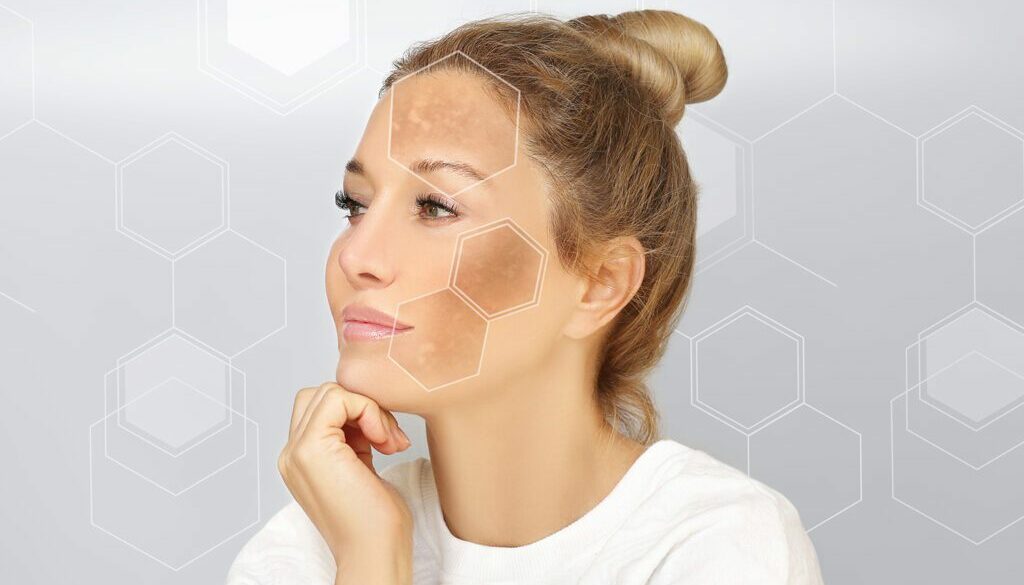Skin Discoloration: Common Causes and Solutions
The skin is the body’s largest organ, serving as a protective barrier and an indicator of overall health. Skin discoloration, characterized by patches of skin that appear darker or lighter than the surrounding area, is a common concern that can have various underlying causes. CMC Dermatology has provided us with some of the most common causes of skin discoloration and discusses potential solutions for the main culprits to help you achieve a clearer, more even complexion.
Three Main Culprits of Skin Discoloration
Hyperpigmentation
Hyperpigmentation is a condition characterized by the darkening of certain areas of the skin. It occurs when there’s an overproduction of melanin, the pigment responsible for skin color. Some common causes of hyperpigmentation include:
- Sun Exposure Prolonged exposure to UV rays can stimulate the production of melanin, leading to uneven skin tone and dark spots.
- Post-Inflammatory Hyperpigmentation (PIH) This occurs after the skin experiences inflammation due to acne, injuries, or skin conditions. As the skin heals, excess melanin can accumulate, causing dark spots.
- Melasma Often referred to as “pregnancy mask,” melasma is a type of hyperpigmentation triggered by hormonal changes, commonly occurring during pregnancy or when using hormonal contraceptives.
Solutions:
- Sun Protection The most effective way to prevent and manage hyperpigmentation is by using broad-spectrum sunscreen daily. Look for a sunscreen with an SPF of 30 or higher and apply it generously and often.
- Topical Treatments Ingredients like hydroquinone, retinoids, vitamin C, and niacinamide can help lighten dark spots and even out skin tone over time.
- Chemical Peels and Laser Therapy These treatments can target hyperpigmentation by promoting skin cell turnover and reducing melanin production.
Hypopigmentation
Hypopigmentation is the opposite of hyperpigmentation, causing areas of the skin to become lighter than usual. It’s often caused by a decrease in melanin production. Some common causes of hypopigmentation include:
- Vitiligo An autoimmune disorder where the immune system attacks melanocytes, leading to loss of pigment in patches of skin.
- Post-Inflammatory Hypopigmentation Similar to PIH, certain skin injuries or conditions can result in a loss of pigment as the skin heals.
- Albinism A genetic condition that leads to little or no melanin production, resulting in very pale skin, hair, and eyes.
Solutions:
- Topical Steroids Dermatologists may prescribe topical corticosteroid creams or ointments to help reduce inflammation and encourage repigmentation in certain cases of hypopigmentation.
- Topical Calcineurin Inhibitors Medications like tacrolimus and pimecrolimus may be recommended for certain conditions like vitiligo to help repigment the skin.
- Topical Immunomodulators Certain topical immunomodulators like topical calcineurin inhibitors may be used to reduce inflammation and encourage repigmentation in autoimmune conditions like vitiligo.
- Camouflage Makeup Cosmetic products can help conceal hypopigmented areas and even out skin tone.
Vascular Issues
Skin discoloration can also result from blood vessel-related issues, causing red or purple marks on the skin. Some common causes include:
- Rosacea A chronic skin condition characterized by facial redness and visible blood vessels.
- Spider Veins These are small, dilated blood vessels that appear close to the skin’s surface and often appear as red or purple lines.
- Hemangiomas These are benign growths of blood vessels that can cause red or purple discoloration.
Solutions:
- Topical Treatments Creams and gels containing ingredients like azelaic acid or metronidazole can help manage redness associated with rosacea.
- Oral Medications In some cases, oral medications like antibiotics (for rosacea) or medications to improve blood vessel function may be prescribed to manage the condition and reduce skin discoloration.
Other Common Causes of Skin Discoloration
Aging Gracefully
As we age, our skin undergoes numerous changes, including alterations in pigmentation. The influence of genetics becomes evident as some people are inherently more prone to develop certain types of skin discoloration. For example, individuals with fair skin may be more susceptible to redness and visible blood vessels, while those with darker skin are at a higher risk for keloids and certain types of hyperpigmentation.
Medical Conditions
Certain medical conditions can manifest as skin discoloration. For instance, eczema and psoriasis can cause red or dark patches due to inflammation. Liver diseases can lead to jaundice, which results in a yellowing of the skin and eyes. Diabetes might cause a condition known as diabetic dermopathy, leading to light brown patches on the shins.
Diet and Environmental Influences
Our lifestyle choices can contribute to skin discoloration as well. A poor diet lacking essential nutrients can affect your skin health, while smoking and excessive alcohol consumption can lead to premature aging and skin damage. Environmental factors, such as pollution and exposure to harsh chemicals, can also create skin discoloration.
Healthy skin starts at CMC Dermatology
Skin discoloration can be a source of concern, but understanding its underlying causes is the first step toward finding effective solutions. Whether it’s hyperpigmentation, hypopigmentation, or vascular issues, there are various treatment options available to help restore a more even and radiant complexion. Consulting with a dermatologist is crucial for accurate diagnosis and personalized treatment plans tailored to your specific skin needs. In addition to professional guidance, adopting a consistent skincare routine and practicing sun protection can go a long way in maintaining healthy, beautiful skin.
For those seeking a dermatology clinic that prioritizes expertise, personalization, advanced technology, and compassionate care, CMC Dermatology is the answer. With a team of skilled professionals dedicated to enhancing your skin health and overall well-being, our clinic offers more than just treatments – it offers a path to healthy beauty that radiates from the inside out. Embark on your journey to vibrant skin with CMC Dermatology today by calling 843-234-8700.




